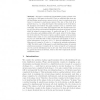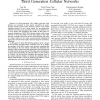708 search results - page 125 / 142 » Timing closure: the solution and its problems |
SSS
2005
Springer
15 years 3 months ago
2005
Springer
This paper considers the self-stabilizing unison problem. The contribution of this paper is threefold. First, we establish that when any self-stabilizing asynchronous unison protoc...
SASO
2009
IEEE
15 years 4 months ago
2009
IEEE
—In sufficiently large heterogeneous overlays message loss and delays are likely to occur. This has a significant impact on overlay routing, especially on longer paths. The exi...
115
click to vote
INFOSCALE
2009
ACM
15 years 4 months ago
2009
ACM
Abstract. Application layer DDoS attacks, to which network layer solutions is not applicable as attackers are indistinguishable based on packets or protocols, prevent legitimate us...
MSS
2007
IEEE
15 years 4 months ago
2007
IEEE
Storage systems manage quotas to ensure that no one user can use more than their share of storage, and that each user gets the storage they need. This is difficult for large, dis...
INFOCOM
2005
IEEE
15 years 3 months ago
2005
IEEE
— In third generation (3G) cellular networks, base stations are connected to base station controllers by pointto-point (usually T1/E1) links. However, today’s T1/E1 based backh...


